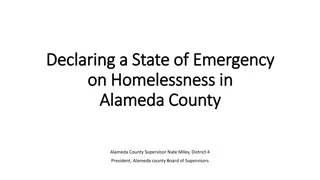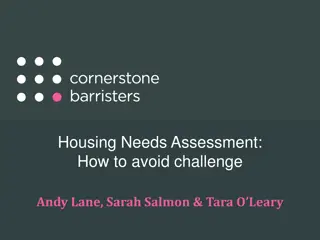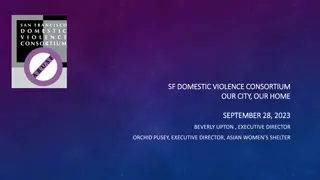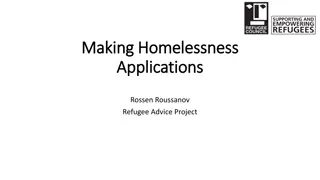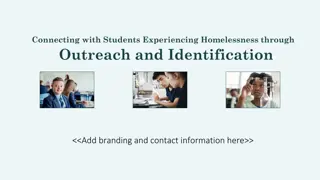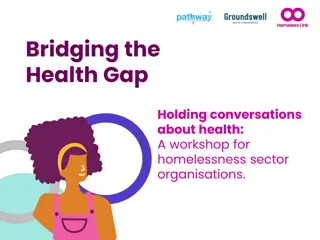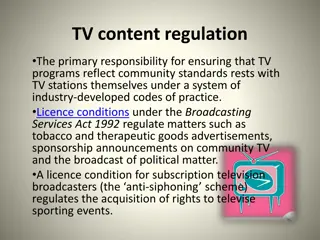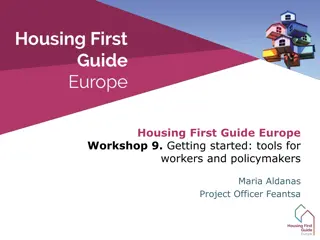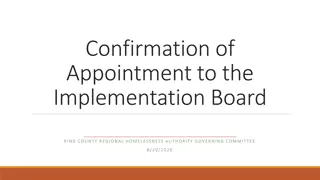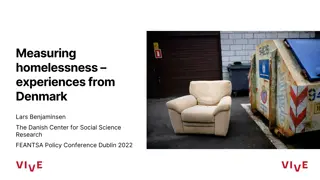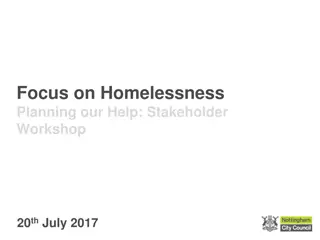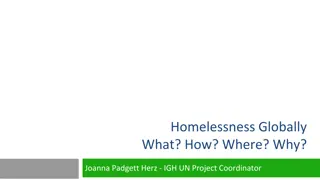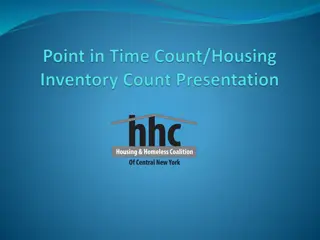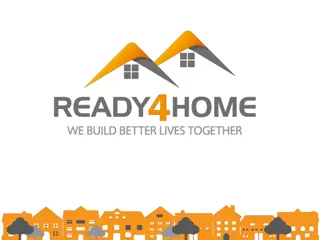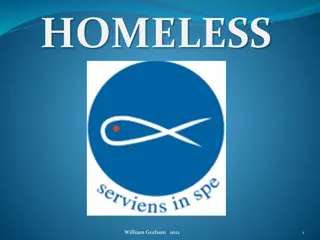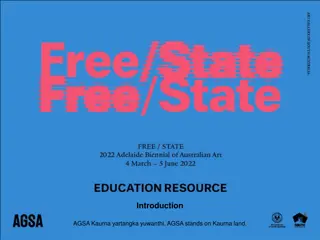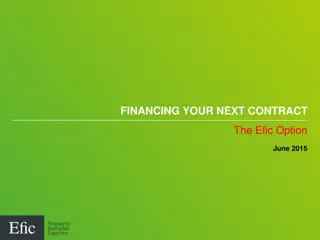Implementing Australian Service Excellence Standards (ASES) in Specialist Homelessness Services
This presentation is part of the ASES Quality Standards Implementation Resource Kit, focusing on self-assessment and developing an ASES Workplan for Specialist Homelessness Services (SHS) teams. It aims to initiate discussions, explore key themes of the Standards, and identify strengths and areas for improvement to meet ASES requirements effectively.
Download Presentation

Please find below an Image/Link to download the presentation.
The content on the website is provided AS IS for your information and personal use only. It may not be sold, licensed, or shared on other websites without obtaining consent from the author. Download presentation by click this link. If you encounter any issues during the download, it is possible that the publisher has removed the file from their server.
E N D
Presentation Transcript
Australian Service Excellence Standards (ASES) NSW Specialist Homelessness Services Quality Standards Implementation Resource Kit What Does ASES Mean for Us? Let s Start the Conversation A presentation for teams
INTRODUCTION This presentation is part of the ASES Quality Standards Implementation Resource Kit It is part of Module 3 which focuses on self-assessment and developing and ASES Workplan It has been developed for SHS teams, working groups and committees working towards ASES accreditation It is designed to be implemented before you start your self-assessment
INTRODUCTION The purpose of the presentation is to support your staff, and stakeholders and any working groups implementing ASES to: start discussing and exploring the key themes of the Standards develop a common understanding of the Standards start identifying where your strengths are in relation to the Standards and where you think your gaps are
INTRODUCTION It is best to do this session after you have watched the two introductory webinars in the Orientation Module
Standard 1: Planning Standard 1 is about strategic and operational planning It has the following key concepts: 1. Our role, values and strategic directions have been articulated and widely shared with clients and other stakeholders 2. We have a strategic plan that was developed in consultation with staff, clients and other stakeholders 3. We identified the threats and opportunities for our organisation in developing the Strategic Plan 4. We considered opportunities for early intervention and prevention that could improve client outcomes in developing the Strategic Plan 5. We have an operational (business) plan with clear responsibilities and timeframes that is linked to our annual budget 6. We have a process for monitoring and reporting against the two plans
Standard 1: Planning Discussion: In relation to the key concepts: 1. How do we as an organisation measure up? 2. What do these requirements look, sound and feel like in our organisation? 3. What do they mean to me in my role? 4. What might we need to change to meet this Standard as an organisation? 5. What will the changes mean for my role? 6. What are the risks if we don t change?
Standard 2: Governance Standard 2 is about governance. It has the following key concepts: 1. Our governing body, such as the Board or Management Committee do a good job in steering the organisation and work together well as a group 2. There are up-to-date policies and procedures to make sure we are following all relevant laws and contractual obligations 3. We can demonstrate that our policies and procedures are consistently applied and regularly reviewed 4. We have good processes to collect and use data and can learn from that data 5. We have effective policies and practices to manage risks
Standard 2: Governance Discussion: In relation to the key concepts: 1. How do we as an organisation measure up? 2. What do these requirements look, sound and feel like in our organisation? 3. What do they mean to me in my role? 4. What might we need to change to meet this Standard as an organisation? 5. What will the changes mean for my role? 6. What are the risks if we don t change?
Standard 3: Financial and Contract Management Standard 3 is about financial and contract management It has the following key concepts: 1. We are responsible and accountable in the way we manage finances 2. We make good use of the resources we have 3. Our assets ( buildings, furniture, cars and other assets) are well managed and get replaced on time 4. We are environmentally responsible 5. The goods and services we buy are good value for money and enable us to do our work
Standard 3: Financial and Contract Management Discussion: In relation to the key concepts: 1. How do we as an organisation measure up? 2. What do these requirements look, sound and feel like in our organisation? 3. What do they mean to me in my role? 4. What might we need to change to meet this Standard as an organisation? 5. What will the changes mean for my role? 6. What are the risks if we don t change?
Standard 4: People Standard 4 is about people It has the following key concepts: 1. Our recruitmentsystem gets us well qualified staff who do the best job for our clients 2. All new starters get a comprehensive induction 3. We are supported with supervision and staff development 4. We maintain a safe work environment in all aspects of our roles 5. We have a work culture that celebrates diversity among staff and clients 6. We have a way of measuring our approach to diversity
Standard 4: People Discussion: In relation to the key concepts: 1. How do we as an organisation measure up? 2. What do these requirements look, sound and feel like in our organisation? 3. What do they mean to me in my role? 4. What might we need to change to meet this Standard as an organisation? 5. What will the changes mean for my role? 6. What are the risks if we don t change?
Standard 5: Partnerships Standard 5 is about partnerships It has the following key concepts: 1. We work collaboratively with other organisations (partners) on agreed goals that benefit clients and the community 2. We consider the need for protocols, performance measures and reporting requirements in our interagency work 3. We monitor and regularly evaluate our work with partner organisations 4. We have a strong team culture within the organization 5. As staff, we feel that systems are in place to encourage us to work collaboratively together 6. Our teamwork and collaboration are directly linked to our strategic directions
Standard 5: Partnerships Discussion: In relation to the key concepts: 1. How do we as an organisation measure up? 2. What do these requirements look, sound and feel like in our organisation? 3. What do they mean to me in my role? 4. What might we need to change to meet this Standard as an organisation? 5. What will the changes mean for my role? 6. What are the risks if we don t change?
Standard 6: Communication Standard 6 is about communication It has the following key concepts: 1. Our communication inside and outside the organisation is clear and succinct 2. We use different communication styles that suit the person or audience we are communicating with 3. We have defined who we communicate with (Internal and external target groups) and the method for commination with different stakeholders 4. We use communication to seek feedback so we can continually improve what we do 5. We have appropriate information sharing protocols with other agencies
Standard 6: Communication Discussion: In relation to the key concepts: 1. How do we as an organisation measure up? 2. What do these requirements look, sound and feel like in our organisation? 3. What do they mean to me in my role? 4. What might we need to change to meet this Standard as an organisation? 5. What will the changes mean for my role? 6. What are the risks if we don t change?
Standard 7: Service Outcomes Standard 7 is about service outcomes It has the following key concepts: 1. We plan and document our service outcomes which are responsive to client and community needs 2. Our service outcomes are consistent with legislation and funding agreements 3. Our service outcomes are evidence-based and include customer service standards 4. We have defined the performance measures for our service outcomes (e.g. quality and quantity, waiting times for access to services, timeliness, cost, satisfaction level) 5. We monitor our progress against the performance measures for our service outcomes
Standard 7: Service Outcomes Discussion: In relation to the key concepts: 1. How do we as an organisation measure up? 2. What do these requirements look, sound and feel like in our organisation? 3. What do they mean to me in my role? 4. What might we need to change to meet this Standard as an organisation? 5. What will the changes mean for my role? 6. What are the risks if we don t change?
Standard 8: Consumer Outcomes Standard 8 is consumer outcomes It has the following key concepts: 1. Our clients are key partners in shaping service delivery and continuous improvement and we allocate resources for their input and participation 2. We provide information about services to clients, the community, public advocates and carers 3. Positive client outcomes are the key focus in program design, delivery and review of services. 4. We have a robust client feedback and complaints system that informs quality improvement 5. Consumer complaint outcomes are reported to management and the Board/Management Committee
Standard 8: Consumer Outcomes Discussion: In relation to the key concepts: 1. How do we as an organisation measure up? 2. What do these requirements look, sound and feel like in our organisation? 3. What do they mean to me in my role? 4. What might we need to change to meet this Standard as an organisation? 5. What will the changes mean for my role? 6. What are the risks if we don t change?
NEXT STEP Now that your team has considered the key elements of all 8 Standards, the next step is to start developing your ASES Implementation Workplan. You will find the instructions and template for developing the Workkplan in the Module 3 resources.





